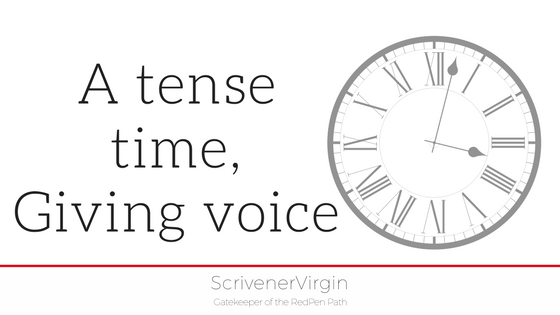A tense time, Giving voice
NaNoWriMo fast approaches and it’s crucial, before I start writing for real at midnight on 31 October, that I make some decision on tense and voice.
First question: which tense to use? Past or present?
- Past tense would be the easy option. It’s the natural way of telling a story – something that happened in the past, recounted now.
- Using the present tense can create a sense of immediacy. It can draw the readers in so they feel they are part of the action, inside the head of the narrator.
If I make the right decision on tense, editing my first draft should be less time-consuming. There is much to read on this topic.
- Mignon Fogerty, GrammarGirl offers a perspective on why one might use the present tense and includes a comprehensive breakdown of all the available tenses.
- Emma Darwin presented a similarly comprehensive list of advantages and drawbacks of using each tense: past and present
- Writer’s Digest also discusses the pros and cons of using the present tense.
- In a Guardian article, Philip Pullman is accused of calling time on the present tense when he criticizes the Booker prize for including present tense novels. There’s further comment on this issue here.
- In another Guardian article, Nicola Morgan lists 10 present tense novels – for children – that she thinks are worth reading.
Choice of tense is a much-discussed topic, and making the right decision is clearly important!
Second question: Who is going to tell this story?
- Whose point of view will be expressed in my story?
- Which character has the main voice?
- Will it be just one person? Or will I have two (or more) threads running parallel?
- Last but certainly not least, what voice will I use: first, second or third person?
Again, the internet has much advice on offer, although a person is not as emotive a subject as tense.
- Randy Ingermanson, the author of ‘Writing Fiction for Dummies’ AKA the Snowflake guy, explains all here.
- Grammar Girl offers her four penn’orth on this topic, with an article by Geoff Pope.
- Writer’s Digest also cover this topic.
Decision time!
Having studied everything, and thought long and hard about this, here’s my plan.
- For one central character, I’ll use present tense and first person. This character, currently called CatAmongThePigeons will reveal his/her back story while ‘being in the moment’.
- For the majority of the rest of the text – the run up to the night of Safari Supper – I’ll use the standard past tense and third person.
- For the three courses of the Safari Supper event, though, I’ll have a narrator – much like the voice-over used in ‘Come Dine with Me’ – who, in the second person, will add comments directed at individual diners. I’m calling that character: ComeDieWithMe. Yes, I left out the ‘n’ on purpose!
So, that’s settled? Unless the characters take over and decide they want to do it differently …
What about you? What are your plans? I’d love to know!
As publicized in a recent posting, as an ex-ML, not available to travel so much this year, I’ll be offering online encouragement through a series of free webinars. My NANO KICK-OFF webinars will be on Monday 26 October and there are three-time slots: 10.30am, 2pm, and 8pm.
What will be on the menu?
- How NaNoWriMo Works
- Where inspiration comes from .. and how to tap into your creative mind
- Tips on time management and survival
If you would like to know more about what’s available, click here.
AND DON’T FORGET TO REGISTER FOR NANO!
The ScrivenerVirgin blog is a journey of discovery:
a step-by-step exploration of how Scrivener can change how a writer writes.
To subscribe to this blog, click here.
Also … check out the Scrivener Tips
on my ScrivenerVirgin Facebook page.



Patsy
15 October 2015 at 14:34I tried writing a novel in present tense once – won’t be trying that again!